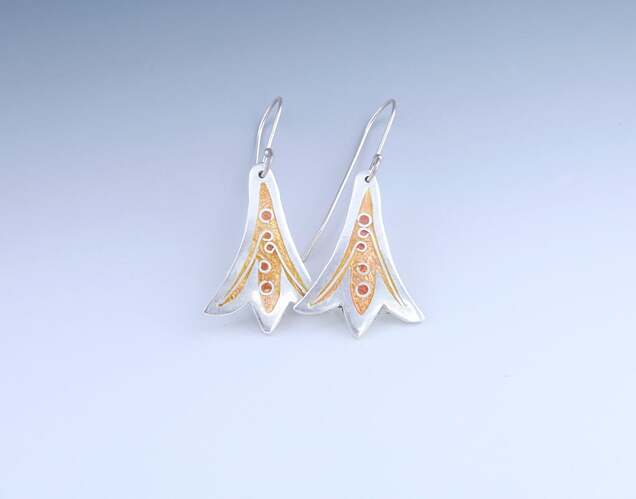Materials: Fine Silver, Sterling Silver, Unleaded Enamel
Dimensions: 2.5 x .75 inches
These earrings are art deco inspired. The color, shape and design are simple and in harmony.
Photo credit: Paula Parks-Fitzhugh
Erin A Brown
Erin Brown Designs
Clayton, NC. USA
I fell into the metalsmithing world completely unaware that it would change my life. I decided to become a stay at home mom and quit being a teacher. During this transition, I took a class on basic metalsmithing to keep myself occupied. As soon as I had a torch in my hand and saw all the possibilities for it, I was in love.
I have always been crafty, thinking about ways to make things prettier or more useful. When I found metalsmithing, I had a direction for all my crafty thoughts. I first started in silver and was content discovering all the tools and forms metal could take. Then I found enameling and it brought my creativity and imagination to a whole new level. I was overwhelmed with the thought of such beautiful color in combination with the metal I had come to revere. It is said the enameling takes a minute to learn and a lifetime to master. I am focused on mastering the cloisonn? technique of enamel.
Each piece begins as an inspiration, usually from the forms found in nature. After I have milled it around in my brain for a while, it takes the shape of a sketch and a color palette. Depending on the piece, the color may come in through enamel or through the use of set stones. Both avenues are equally striking. From the sketch, the fabrication begins in my at home studio with my hands and my trusty set of tools. Forming and coloring metal is very much based in science, but feels like magic. It is awe-inspiring when I look at what I started with and what comes out at the end.
The pieces I create are made one at a time and are personal masterpieces. I have come to love metalsmithing so much that each piece receives the best I have to offer; we are talking blood sweat and tears. I have found that by pouring everything I have into a piece, you get the greatest outcome and the most moving art.
The exhibition explores metal works whose primary theme is color embraced as their primary visual focus, whether that be using colored materials, exploring creating colored surfaces, or encasing the object in color.
As the world's largest jewelry related internet site, Ganoksin strives to develop exhibitions showcasing work from around the world. This exhibition was open to all metalsmiths, professional and amateur, advanced and beginner.
In total 303 artists contributed 814 show pieces for the permanent online exhibition.
The exhibition was curated by Beth Wicker, President of the North Carolina Society of Goldsmiths in the United States, and Adjunct Instructor at Northeastern Technical College in South Carolina. Director of the exhibition is Hanuman Aspler, founder of The Ganoksin Project, the world's largest internet jewelry site.
Hue is one of the primary properties of color, it refers to the place the color occupies on the visual spectrum. Humans have used hues throughout time, to create cave paintings, to decorate themselves, their clothing and their housing.
Different hues have taken on different meanings throughout time. Gold traditionally has been a color of purity - the metal gold is relatively unchangeable, and the hue of gold has come to stand for gods and goddesses, for royalty, for durability and for purity. Red has often meant love, or passion. Hues often reflect the meaning of the seasons, with pastels referring to spring and the burst of new life after the pale hues of winter. Summer is reflected in vibrant, deep hues, followed by the browning of hues in the fall as plants go to seed and die, and the land turns fallow.
The worth of a hue has often been tied to what is necessary to make the pigment that creates the hue, and the expensive involved in the process. Often created from crushed stones that had to be mined and carried by caravan over thousands of miles, or from fermented roots of plants only grown in certain areas, or the carapaces of rare insects - the creation of hue in a way that could be used by man was an involved and generally expensive process.
In today's world metalsmiths have access to perhaps the widest range of materials and hues in the history of man - and in some of the most affordable ways ever.
This exhibition celebrates hue - color - as an integral, inherent element of the work. We talk of the "richness" of color, and examples of this abound here. One expects hues from the colors of gemstones used in metalsmithing, but we also have hues from some less expected places. Glass enamels are an ancient way of adding color, as are a variety of patinas. Today's artists also use synthetic man-made materials to add color in ways that didn't exist a century ago.
We invite you to enjoy this celebration of hue, and the ways hues and their use have changed over time.
